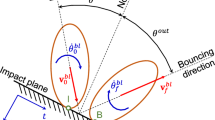Abstract
Numerical modelling techniques enable forcing function at the point of contact in a hail impact to be predicted, but many models available in commercial software have not been verified by experiments. A recently developed deterministic model is only able to simulate the impact action of an idealised spherical hailstone. Results recorded from the impact testing of non-spherical simulated hail ice specimens show wide scatters and are different to spherical specimens. A stochastic model has been developed in this study to incorporate the variability of the modelling parameters representing the behaviour of non-spherical ice specimens and to generate time histories of contact force for given impact scenarios. A probabilistic model which was developed previously to provide predictions of the distribution of the size of hailstones in a severe category hailstorm has also been further developed to provide predictions of the maximum contact force values in probabilistic terms. For any given pre-defined forcing function denting into the surface of a steel plate can be estimated by finite element analysis or experimentally on a test machine. The new knowledge base introduced in this paper can be used by manufacturers and designers to re-assess existing products and in making improvements to future installations taking into account cost–benefit considerations.



















Similar content being viewed by others
References
Anghileri M, Castelletti ML, Invernizzi F, Mascheroni M (2005) A survey of numerical models for hail impact analysis using explicit finite element codes. Int J Impact Eng 31:929–944. https://doi.org/10.1016/j.ijimpeng.2004.06.009
ANSI/FM_4473 (2011) ANSI/FM 4473 Test Standard for Impact Resistance. Testing of rigid roofing materials by impacting with Freezer Ice Balls. ANSI/FM 4473. FM Approvals LLC, Norwood, MA
Appleby-Thomas GJ, Hazell PJ, Dahini G (2011) On the response of two commercially-important CFRP structures to multiple ice impacts. Compos Struct 93:2619–2627. https://doi.org/10.1016/j.compstruct.2011.04.029
Combescure A, Chuzel-Marmot Y, Fabis J (2011) Experimental study of high-velocity impact and fracture of ice. Int J Solids Struct 48:2779–2790. https://doi.org/10.1016/j.ijsolstr.2011.05.028
Flueler P (2009) Hail impact resistance of building materials. Istanbul Technical University, Istanbul, Turkey. http://www.rci-online.org/interface/2009-09-flueler.pdf/. Accessed 13 June 2014
Fraile R, Castro A, López L, Sánchez JL, Palencia C (2003) The influence of melting on hailstone size distribution. Atmos Res 67–68:203–213. https://doi.org/10.1016/S0169-8095(03)00052-8
Gessler S, Petty SE (2013) Hail fundamentals and general hail-strike damage assessment methodology. In: Petty SE (ed) Forensic engineering [electronic resource]: damage assessments for residential and commercial structures. CRC Press, Taylor & Francis Group, Boca Raton
Kim H, Kedward KT (2000) Modeling hail ice impacts and predicting impact damage initiation in composite structures. AIAA J 38:1278–1288. https://doi.org/10.2514/2.1099
Kim H, Welch D, Kedward K (2003) Experimental investigation of high velocity ice impacts on woven carbon/epoxy composite panels. Compos Part A Appl Sci Manuf 34:25–41
Lam N, Tsang HH, Gad EF (2009) Simulation of response to low velocity impact by spreadsheet. Struct Stab Dyn 10:9. https://doi.org/10.1142/S0219455410003580
Marshall TP, Herzog RF, Morrison SJ, Smith SR (2004) Hail damage to tile Roofing. Paper presented at the 22nd conference on severe local storms, 2004 October 6
Matson RJ, Huggins AW (1980) The direct measurement of the sizes, shapes and kinematics of falling hailstones. J Atmos Sci 37:1107–1125. https://doi.org/10.1175/1520-0469(1980)037<1107:TDMOTS>2.0.CO;2
Olsson R, Juntikka R, Asp LE (2013) High velocity hail impact on composite laminates—modelling and testing. In: Abrate S, Castanié B, Rajapakse SYD (eds) Dynamic failure of composite and sandwich structures. Springer, Dordrecht, pp 393–426. https://doi.org/10.1007/978-94-007-5329-7_9
Park H, Kim H (2010) Damage resistance of single lap adhesive composite joints by transverse ice impact. Int J Impact Eng 37:177–184
Paterson DA, Sankaran R (1994) Hail impact on building envelopes. J Wind Eng Ind Aerodyn 53:229–246. https://doi.org/10.1016/0167-6105(94)90028-0
Perera S, Lam N, Pathirana M, Zhang L, Ruan D, Gad E (2016) Deterministic solutions for contact force generated by impact of windborne debris. Int J Impact Eng 91:126–141. https://doi.org/10.1016/j.ijimpeng.2016.01.002
Sharafi P, Teh LH, Hadi MNS (2013) Theory based sensitivity analysis and damage detection of steel roof sheeting for hailstone impact. In: Catbas F, Pakzad S, Racic V, Pavic A, Reynolds P (eds) Topics in dynamics of civil structures, vol 4. Conference Proceedings of the Society for experimental Mechanics series. Springer, New York, NY
Shimek E, Ekwaro-Osire S, Rasty J (2011) Probabilistic analysis of steel roof damage from hail strike. In: ASME 2011 international mechanical engineering congress and exposition. American Society of Mechanical Engineers, pp 503–510
Sun J, Lam N, Zhang L, Ruan D, Gad E (2015) Contact forces generated by hailstone impact. Int J Impact Eng 84:145–158. https://doi.org/10.1016/j.ijimpeng.2015.05.015
Tippmann J, Kim H, Rhymer J (2013) Experimentally validated strain rate dependent material model for spherical ice impact simulation. Int J Impact Eng 57:43–54
Yang Y, Lam N, Zhang L (2012a) Estimation of response of plate structure subject to low velocity impact by a solid object. Int J Struct Stab Dyn 12:1250053. https://doi.org/10.1142/S0219455412500538
Yang Y, Lam N, Zhang L (2012b) Evaluation of simplified methods of estimating beam responses to impact. Int J Struct Stab Dyn. https://doi.org/10.1142/S0219455412500162
Author information
Authors and Affiliations
Corresponding author
Appendices
Appendix 1: Time step integration algorithm for solving nonlinear viscoelastic 2DOF mass–spring–damper system model
Appendix 2
The values of peak contact force generated by spherical SHI and non-spherical SHI specimens at that particular impact velocity were first measured using the custom-made measuring device. The mean value of the peak contact force for spherical SHI specimens (shown in Table 3) was then calculated based on averaging the test results across ten number of spherical SHI specimens. For non-spherical SHI specimens, the average value of the peak contact force was obtained based on averaging the test results of at least 30 number of non-spherical SHI specimens impacting onto the target at that specific velocity.
Rights and permissions
About this article
Cite this article
Perera, S., Lam, N., Pathirana, M. et al. Probabilistic modelling of forces of hail. Nat Hazards 91, 133–153 (2018). https://doi.org/10.1007/s11069-017-3117-7
Received:
Accepted:
Published:
Issue Date:
DOI: https://doi.org/10.1007/s11069-017-3117-7





